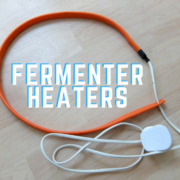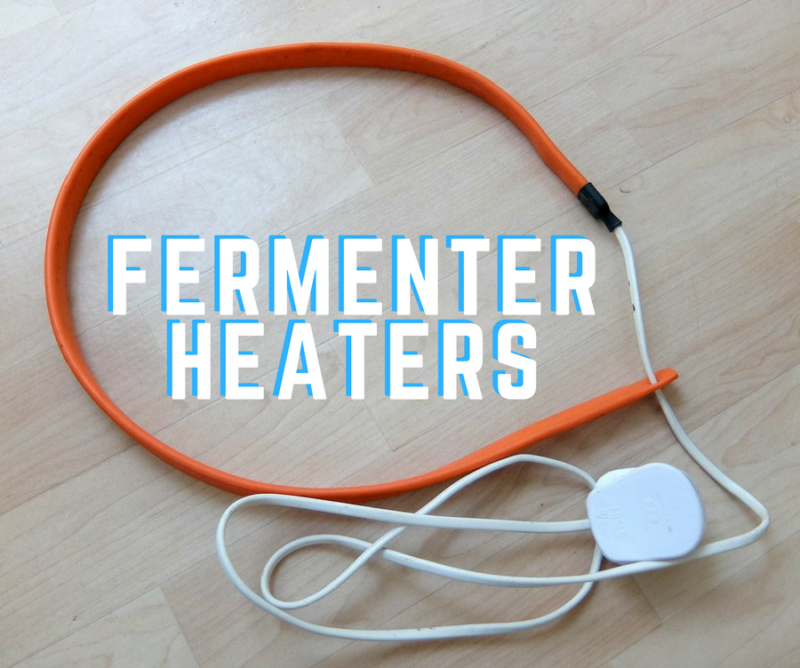Fermenter Heaters: Home Brew Heat Pads & Brew Belts
Brewing as the weather cools can pose a few problems depending on where you live. As the weather cools we have to make sure we are still getting a good temperature for yeast to ferment the beer. Ideally, we want to control fermentation temperature as close as possible to the optimum temperature range for the yeast strain we are using. Using the help of fermenter heating devices like brew belts and heat pads it becomes a lot easier to dial in a consistent temperature in the fermenter even when ambient temperatures begin to fall.
Most ale yeast strains require temperatures ranging around 18°C – 23°C depending on the strain. Devices like brew belts and heat pads provide enough heat to keep the fermenter warm but not enough to warm the fermenter too much and distress the yeast.
Table of Contents
Home Brew Fermenter Heaters
Heat pads and heat belts are the most economical way to keep you fermenter temperature from dropping too low. Rather than having to heat a whole room you are directly heating the fermenting beer or wine. Both types of device use very little energy and are suitable for both fermenting buckets or carboys and demijohns (although I would urge caution directly heating cold glass).
Heat belts and pads are also fairly inexpensive and with the addition of some other tools can be used to accurately control fermentation temperatures to within a few degrees.
Home Brew Heat Pads
Heat pads or heat trays are designed to sit your fermenter on top of. Heating the fermenter from the bottom and maintaining a constant temperature throughout fermentation.
Power Usage: Most heat pads have heat sources around 30 – 40 watts so are pretty energy efficient, more so than a traditional incandescent light bulb in most cases. This provides a low heat so as not to shock the yeast in the fermenting beer.
Big swings in temperature are not good for yeast health and may cause unwanted flavour compounds to be produced by the yeast. The gentle heat from a heating pad gradually brings up the temperature of the beer and depending on the ambient temperature will maintain it in temperature ranges required for most ale or wine fermentations.
Controlling Fermentation Temperature With A Heat Pad
Most home brew heat pads do not have thermostats which means you will want to monitor the temperature closely throughout fermentation.
The concern is that the fermentation temperature will rise too much and this will put the yeast under stress which will generate undesirable flavours in the finished beer. A few things you may want to consider are:
Placing the fermenter in an area that is fairly stable in temperature (albeit cooler), without large fluctuations in the temperature range.
Enclosing the fermenter in a confined space such as a cupboard will gradually build up heat compared to an open space.
Additional measures like timers or third-party thermostats will give much finer control of fermentation.
Additional Fermenter Heater Temperature Control
With regards to the last point a means of moderating the heat output can be a very good way to ensure the fermenter stays exactly in the range you want. If the heat pad has a tendency to warm the fermentation too much then by cycling the heat pad on and off with something like a timer can greatly aid the degree of control you have.
Another option could be to use a dedicated thermostat controller such as an Inkbird which I have reviewed here. This will cycle the home brew heater according to the current temperature of the beer or wine. This would be the most precise way to control the fermentation temperature with a heat pad or tray.
Home Brew Heat Belts – Brew Belt
Heat belts or Brew Belts are similarly energy efficient like heat pads but are designed to wrap around the fermenter and provide heat along the length of the belt.
Most fermentation brew belts are simply a rubber strip with the heating element inside that has the flexible power cord threaded through. The heat belt is wrapped around the fermenter and the cord pulled tight so it grips around the fermenter at the height you choose (more on this in a moment).
Power Usage: Most fermentation heat belts are pretty efficient, using between 25 – 40 watts in most cases so running for a week or two costs very little.
One benefit of a heat belt is that they tend to be slightly cheaper than heat pads in some areas.
The real difference between brew belts and heat pads are that you position the heat belt up or down the fermenting vessel allowing some degree of temperature control. Generally, it is advised to place the belt lower down the fermenter to provide more heat and higher up the vessel for less heat. Without taking a direct temperature reading of the beer this is quite a tricky thing to get right and I would still be inclined to use some additional controls mentioned above, such as a temperature controller or a timer.
Direct Heat From A Fermenter Heater
The way in which a heating device heats the fermenting beer or wine is another thing to consider.
A heat pad heats from the bottom of the fermenter whereas the heat brew belt is positioned around the side some way up.
The thing to think about here is that the heat pad spreads heat across a large surface area, however, at the bottom of the vessel where all the yeast tends to flocculate toward the end of fermentation. Heating the yeast directly for too long is probably not ideal so you may want to limit the length of time you use a heat pad to just a week to avoid putting too much stress on the mass of yeast.
A brew belt applies heat in a smaller surface area but directly on the fermenting wort or must rather than the yeast which you may or may not be better. I have done no tests on this so you have to decide for yourself which you prefer.
Are Fermenter Heaters Worth It?
I use a brew belt during the cooler months of the year as the room where my fermenter sits is a little colder than the rest of the house. I would find it a struggle to ferment properly without one. I use the fermenter belt with a temperature controller so it cycles on and off and keeps my home brew within a few degrees either side of my target temperature.
In my setup it is indispensable, I have talked before about how important temperature control is so if you find you need some help keeping your home brew at a good temperature range a fermenter heater such as a heat mat or a brew belt may be an inexpensive way to do it.







Hey Neil, before I switched over to a fermentation chamber, I also had luck with using a electric blanket in a bind.
That’s a good tip, insulation and a heat source. Thanks Joe.
Are you aware of any concerns about fire hazards with these products? Seems a bit sketchy to leave a heating element on all the time without monitoring it.
I have not heard of any incidents with brew belts or heat pads. When I use them I cycle them on and off with a thermostat so they are not on constantly but I would assume they have build in safety features to prevent overheating.
How would connect a thermostat to a heat belt or pad?
Thermostats like the one linked in the article have their own plug socket to plug the heat belt into.
I use a heat pad and it gets my temperature to over 26 degrees Celsius (With thermometer Strip Mid way up fermenter). I’m worried that the temperature at the bottom is much higher, where yeast is settling. Does anyone know how much higher it could be?
Hi Neil
My ambient temperature is between 12 degrees celcius in the morning and 18 during the day.
I have a reprile heating pad and a timer plug which can swith on and off at pre programmed intervals.
I filled my stainless steel fermenter with water and now I am going to try and figure out the best on/off intervals to maintain a constant temperature – i was wondering if you have any suggestions at all?
Forgot to mention
If i leave it on the whole time the temperature goes up to about 24 during the day and about 18 at night.
I would say heating overnight to try and maintain the 18 degrees would be the best way to work at just maintaining consistency. It is going to be trial and error though.